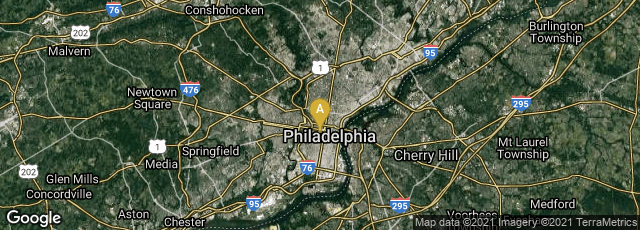

A: Philadelphia, Pennsylvania, United States
On the night of July 4, 1776, by order of the Second Continental Congress, immediately after its approval of the text of the Declaration, Philadelphia printer John Dunlap printed approximately 200 copies of The Declaration of Independence as a broadside. The following day copies were delivered to the President of the Continental Congress, John Hancock, who sent them to the state governors on July 5 and 6.
The text of the Declaration was reprinted in the The Pennsylvania Evening Post newspaper for Saturday, July 6 (vol. II, number 228) published in Philadelphia by Benjamin Towne. This was the first newspaper printing and the second printing chronologically. Within a month of Dunlap's broadside printing a dozen regional broadside editions were printed, all of the greatest rarity, as far north as Salem, Massachusetts, and Exeter, New Hampshire, and as far south as Charleston, South Carolina. However, it is likely that even more Americans read the words of the Declaration in one of the many newspaper printings, of which Clarence Brigham identified thirty in the month of July 1776, produced in eighteen cities and towns ranging from Portsmouth, New Hampshire, to Williamsburg, Virginia.
Copies of the Declaration of Indpendence were read publically by Colonel John Nixon from from a platform behind the Pennsylvania Statehouse (Independence Hall) on July 8, and on July 9 by George Washington on the commons of New York City to the Continental Army and local citizens, who celebrated by tearing down the statue of George III in Bowling Green. On July 28 Viscount Admiral Richard Howe of the British Navy intercepted a copy and dispatched it to London.
Regarding the first printing of the broadside:
"There is evidence that it was done quickly, and in excitement — watermarks are reversed, some copies look as if they were folded before the ink could dry and bits of punctuation move around from one copy to another. 'We were all in haste,' John Adams later wrote."
Surprisingly these printed broadsides, of which 25 copies survived in 2008, are the earliest records of the final draft of the document, as the original manuscript draft from which the broadside was printed no longer survives.
The manuscript dated July 4, 1776 in the National Archives was back-dated. A fair copy of the Declaration of Independence, which Thomas Jefferson wrote out in the week after July 4, 1776, is preserved in the New York Public Library. This is one of two surviving fair copies in Jefferson's hand.
"A copy was also preserved by the Secretary of the Congress, Charles Thompson, in his minutes book; and it was to this text that a scribe, commissioned by the Congress, turned when preparing the ceremonial manuscript copy of the Declaration on parchment, preserved at the National Archives in Washington, D.C., which was signed by members of the Continental Congress on August 2, 1776. The printed Declaration of Independence thus predates the famous copy, signed by John Hancock et al., by nearly a month. The printed copy bears only the names, in type, of Hancock and Thompson on behalf of the Congress, and of the printer John Dunlap; it was the promulgation of an act of Congress and needed nothing more. The text of the ceremonial copy differs from that of the printed original only in its title: it became a “Unanimous Declaration” only later in July 1776, when New York State’s members of Congress changed their vote from abstention to the affirmative" (http://chapin.williams.edu/exhibits/founding.html#declaration, accessed 04-20-2012).
Brigham, History and Bibliography of American Newspapers (1947), 2:931–33. Walsh, "Contemporary Broadside Printings of the Declaration of Independence," Harvard Library Bulletin, 3 (1949).